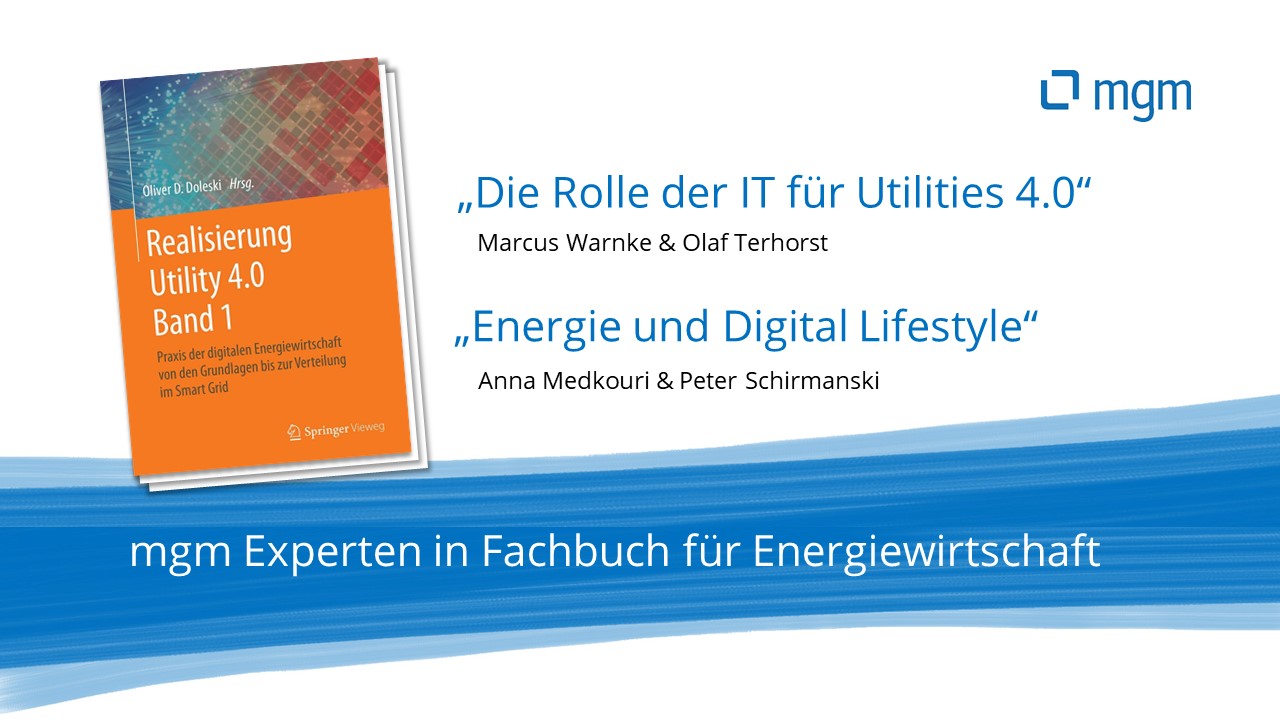
More from author Marcus Warnke in “Realisierung Utility 4.0”
Like many other industries, the energy industry is in the midst of a digital transformation. The two-volume specialist publication “Realization Utility 4.0”, which has been published by Springer-Verlag, sheds light on how this transformation can be successfully managed.
Olaf Terhorst and Marcus Warnke dedicate their chapter to the role of IT for Utilities 4.0.
Increasing volatility in power generation and demand poses challenges for energy suppliers
In the first quarter of 2020, electricity was for the first time predominantly, i.e. >50%, generated from renewable sources (Source: Federal Statistical Office). However, generating electricity largely from renewable sources also means that generation is volatile, i.e. different amounts of energy are generated at different times regardless of demand. This leads to two main effects on the electricity market:
- Overcapacities that have to be redistributed expensively through redispatching measures and
- volatile prices on the market due to the sometimes high availability of electricity quantities, even at peak load times.
In the future, the higher share of fluctuating renewable energies will require greater flexibility in the demand for energy. Services will have to be newly created and prices for grid services will have to be calculated to make them possible. New, variable use scenarios for energy must be developed.
“The volatility associated with this development can only be countered with suitable, data-driven control mechanisms that mitigate these effects,” says Marcus Warnke. In his function as a manager at mgm consulting partners he has worked for many energy companies and has been involved with the market for years. IT plays an essential role in the development of these mechanisms. “It is becoming a determining factor in business activity,” he believes. The previously prevailing opinion that the business already knows the market and will develop the right solutions is no longer valid in times of change. IT is becoming a determining factor in business. IT is business and business is IT.
IT is becoming a determining factor of business activity.
IT is no longer just an internal service provider or driver of innovation, but rather a central hub for optimizing existing and building future business activities. Only if IT and business communicate at eye level can the needs of the market be met in an appropriate manner. IT should ask itself how to structure and process the large volumes of data and how to create new applications from them. Business, on the other hand, should question what consumers and the market really need at present and what will be in demand in the future. So IT and business stand side by side, looking in the same direction, but from different perspectives: on the one hand, in the direction of the customer and the market, and on the other, in the direction of the data and its usability. From this area of conflict, it is necessary to develop new services and application purposes with master data and consumption data, which can only be driven jointly by IT and business.
The role of IT in the organization must be redefined
Due to the changed roles and tasks of IT, the interaction between IT and other organizational units is also shifting. The separation of business and IT, which has long been practised, must be questioned and put to the test. Today, many energy supply companies have an IT department whose business partner takes care of certain specialist areas. Some know how finance works and others know what the network needs. This is a differentiated form of service provision, which in the past could also make sense, but today it is not sufficient to meet the changes in the market.
In many large energy supply companies, IT is subordinated to other board departments in the function of the CIO or CDO and is often seen primarily as a support function, i.e. a cost pool. In municipal utilities the terms may differ, but the problem of IT management by other board members or the question of the role and positioning of IT in the company remains the same.
The fundamental decision as to which role IT should play in the organization in the future must be made at a strategic level.
The fundamental decision about the future role of IT in the organization must be made at a strategic level: Does it continue to provide only a service function or is it an equal partner in the digitalization of the business? Should it be completely or partially outsourced to a service company and offer its services to third parties? Is it possibly helpful to promote two IT areas with different speeds and risk profiles? Or is IT, as an important player in the strategic positioning and success of the business model, anchored at the top management level in the future and co-responsible for the entire company?
Whatever the answers are, at the operational level it is essential to bring the innovative power and specialist knowledge of IT back into the specialist departments (sales, production, procurement/trade, network economy) in order to become more innovative again and keep pace with digitisation and its new business models. Only if the awareness of the advantages of interdisciplinary cooperation is permanently anchored in the minds of the employees on both sides and merges into the DNA of the organisation, innovative products can be developed that will secure future business. In this cooperation, IT plays an essential role for the further development and future positioning of the company.
DevOps as an organizational form for a more efficient collaboration between business and IT
One possibility, which is already used by some companies in IT, is to develop so-called “DevOps” as an organizational form for future scenarios. The term DevOps is an artificial word that is made up of the terms Development and IT Operations and describes a process improvement approach from the areas of software development and system administration. DevOps consist of developer and operator and are intended to improve the quality of software solutions and their development and delivery speed on the one hand, and to enable more effective and efficient cooperation between the areas on the other. In a fast-moving world, experience shows that it makes sense to have colleagues who are specialized in operating a functioning IT system work closely with those who are able to change a system quickly. And this is equally true on the business side, which is why the role of the Business DevOps as counterparts for the IT DevOps is establishing itself there.
The architectures of IT and the process models for observing and reacting to the market must change fundamentally.
“The architectures of IT and the procedural models for observing and reacting to the market must change fundamentally,” Marcus Warnke is certain. This requires IT know-how and the corresponding architects, i.e. systems engineers in the business departments. More and more cross-functional teams need to be formed that work closely together and jointly answer the new questions.
This does not happen overnight, because such a development entails changes on many levels, e.g. in methods of cooperation and product development (design thinking, agile processes), work and management culture (in particular shifting responsibility to the teams) and ultimately control and performance measurement.
These changes cannot be implemented abstractly, but only very concretely. It has proven to be a good idea to use new initiatives (e.g. for the digitalization of customer interfaces) to try out and anchor new procedural models. This can then gradually be extended to other projects and areas. The challenge of behavioral change for employees and managers should not be underestimated. Support by (agile) coaches for teams and managers, tailored training and clear change communication are almost always necessary and can also be tested and anchored in the first initiatives.
Energy suppliers in Germany are not yet sufficiently prepared for the future
According to Marcus Warnke, the level of development among the approx. 1,200 energy suppliers in Germany varies greatly and is in part heavily dependent on size. From small municipal utilities to large corporations serving 15 million customers across Europe, companies have varying degrees of capacity and resources available to them to meet the developments. “Some are still trying to rescue themselves from the Stone Age. Many are on a medium level. Your IT department may already be well structured and already follows an industrial production model,” says Marcus Warnke.
Important impulses on how IT can be changed often come from the business or directly from customer demand.
Many companies are already considering how to optimize their IT, for example by outsourcing or reintegrating IT tasks. However, important impulses often come from another side, namely from the business or directly through customer demand for new products or services, which forces utilities to reorganise the cooperation between IT and business departments in order to be able to serve them.
Conclusion
No matter where companies are today, they must no longer think of their future business in terms of energy production and distribution, but must design it based on the customers, their actual energy use and the data generated by it.
How this data is best used, processed and managed also depends on the level of IT development and the strategic orientation of the energy supply company.
Three scenarios can be outlined: Smaller utilities must ask themselves whether, in view of the complexity, development needs and security requirements, they are well advised to continue to operate the IT themselves or whether it would not be better to outsource it completely, purchase large parts of it or at least operate the IT together with other utilities as partners.
Medium-sized utilities should examine whether and how their IT can contribute to differentiation from the market. The “industrialised IT” model can provide orientation in this respect, in which IT operations are standardised as far as possible and the focus is on further development. The manageable size often offers speed advantages: Some municipal utilities have already brought innovative products onto the market, which they now offer to third parties.
Large utilities have often already begun to develop a dedicated digitization strategy to take advantage of the large volumes of data for product development and customer loyalty. They are experimenting with DevOps working methods, adapting their IT architectures and moving more and more data to flexible cloud services.
The companies need long-term data “ownership”.
But one thing is the same for everyone, regardless of whether IT is operated by the company itself, cloud services are used or processes are completely outsourced: In the long term, companies need data “ownership” and must constantly strive to use this data to improve and expand their products and services in line with customer interests and expectations.
More from author Marcus Warnke in “Realisierung Utility 4.0”
Like many other industries, the energy industry is in the midst of a digital transformation. The two-volume specialist publication “Realization Utility 4.0“, which has been published by Springer-Verlag, sheds light on how this transformation can be successfully managed.
Olaf Terhorst and Marcus Warnke devote their chapter to the role of IT for Utilities 4.0. In their experience, IT is currently becoming a determining factor, independent of the business model. Where IT used to act as a service provider for the specialist departments or the business, it is now becoming the central hub. IT is business and business is IT.
Please also see “mgm participates in comprehensive specialist publication “Realization Utility 4.0”.









